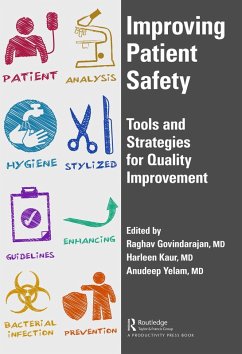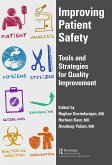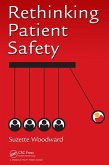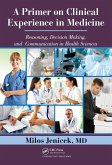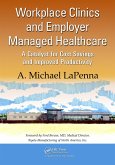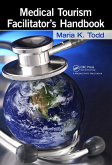Improving Patient Safety (eBook, PDF)
Tools and Strategies for Quality Improvement
Redaktion: Kaur, Harleen; Yelam, Anudeep


Alle Infos zum eBook verschenken

Improving Patient Safety (eBook, PDF)
Tools and Strategies for Quality Improvement
Redaktion: Kaur, Harleen; Yelam, Anudeep
- Format: PDF
- Merkliste
- Auf die Merkliste
- Bewerten Bewerten
- Teilen
- Produkt teilen
- Produkterinnerung
- Produkterinnerung

Hier können Sie sich einloggen

Bitte loggen Sie sich zunächst in Ihr Kundenkonto ein oder registrieren Sie sich bei bücher.de, um das eBook-Abo tolino select nutzen zu können.
Based on the IOM's estimate of 44,000 deaths annually, medical errors rank as the eighth leading cause of death in the U.S. Clearly medical errors are an epidemic that needs to be contained. Despite these numbers, patient safety and medical errors remain an issue for physicians and other clinicians. This book bridges the issues related to patient safety by providing clinically relevant, vignette-based description of the areas where most problems occur. Each vignette highlights a particular issue such as communication, human facturs, E.H.R., etc. and provides tools and strategies for improving…mehr
- Geräte: PC
- mit Kopierschutz
- eBook Hilfe
- Größe: 4.77MB
![Improving Patient Safety (eBook, ePUB) Improving Patient Safety (eBook, ePUB)]() Raghav GovindarajanImproving Patient Safety (eBook, ePUB)30,95 €
Raghav GovindarajanImproving Patient Safety (eBook, ePUB)30,95 €![Rethinking Patient Safety (eBook, PDF) Rethinking Patient Safety (eBook, PDF)]() Suzette WoodwardRethinking Patient Safety (eBook, PDF)33,95 €
Suzette WoodwardRethinking Patient Safety (eBook, PDF)33,95 €![Rethinking Rehabilitation (eBook, PDF) Rethinking Rehabilitation (eBook, PDF)]() Rethinking Rehabilitation (eBook, PDF)112,95 €
Rethinking Rehabilitation (eBook, PDF)112,95 €![A Public Health Strategy for Living, Aging and Dying in Solidarity (eBook, PDF) A Public Health Strategy for Living, Aging and Dying in Solidarity (eBook, PDF)]() Mary Beth MorrisseyA Public Health Strategy for Living, Aging and Dying in Solidarity (eBook, PDF)39,95 €
Mary Beth MorrisseyA Public Health Strategy for Living, Aging and Dying in Solidarity (eBook, PDF)39,95 €![A Primer on Clinical Experience in Medicine (eBook, PDF) A Primer on Clinical Experience in Medicine (eBook, PDF)]() Milos Jenicek MDA Primer on Clinical Experience in Medicine (eBook, PDF)99,95 €
Milos Jenicek MDA Primer on Clinical Experience in Medicine (eBook, PDF)99,95 €![Workplace Clinics and Employer Managed Healthcare (eBook, PDF) Workplace Clinics and Employer Managed Healthcare (eBook, PDF)]() A. Michael LapennaWorkplace Clinics and Employer Managed Healthcare (eBook, PDF)55,95 €
A. Michael LapennaWorkplace Clinics and Employer Managed Healthcare (eBook, PDF)55,95 €![Medical Tourism Facilitator's Handbook (eBook, PDF) Medical Tourism Facilitator's Handbook (eBook, PDF)]() Maria K. ToddMedical Tourism Facilitator's Handbook (eBook, PDF)59,95 €
Maria K. ToddMedical Tourism Facilitator's Handbook (eBook, PDF)59,95 €-
-
-
Dieser Download kann aus rechtlichen Gründen nur mit Rechnungsadresse in A, B, BG, CY, CZ, D, DK, EW, E, FIN, F, GR, HR, H, IRL, I, LT, L, LR, M, NL, PL, P, R, S, SLO, SK ausgeliefert werden.
- Produktdetails
- Verlag: Taylor & Francis
- Seitenzahl: 298
- Erscheinungstermin: 15. Januar 2019
- Englisch
- ISBN-13: 9780429649752
- Artikelnr.: 55263392
- Verlag: Taylor & Francis
- Seitenzahl: 298
- Erscheinungstermin: 15. Januar 2019
- Englisch
- ISBN-13: 9780429649752
- Artikelnr.: 55263392
Harleen Kaur, MD is a clinical researcher at University of Missouri Columbia, Department of neurology. She has strong passion patient safety and quality improvement which was triggered after experiencing a personal tragic event that affected the care of one of her loved ones. In addition to multiple publications and presentations she has a strong passion for patient centered care.
Anudeep Yelam, MD is a clinical researcher at University of Missouri Columbia, Department of neurology. He has a significant experience working as a volunteer physician in multiple rural hospitals providing care to the underserved population. It is this experience in rural medicine that prompted his interest in developing system based care and use of technology to improve the quality of care in rural settings.
Editors
List of Contributors
1 Introduction to Patient Safety and Medical Errors
NAKUL KATYAL
2 Developing an Outline for Patient Safety Curriculum
NAKUL KATYAL
3 Understanding System Errors
Section 1 Human Factors Engineering
Clinical Vignette 1: Every Sound Alarms
DANISH KHERANI
Clinical Vignette 2: Man and His Machine
AHMER ASIF
Clinical Vignette 3: Expensive Gift
ANUDEEP YELAM
Section 2 Communication Issues
Clinical Vignette 1: Doctors Are from Mars and Nurses Are from Venus!
TRIPTI CHOPADE
Clinical Vignette 2: Different Paths Yet the Same Goal
TRIPTI CHOPADE
Clinical Vignette 3: It Was Erik's Fault!
TRIPTI CHOPADE
Clinical Vignette 4: You Are Not Alone!
TRIPTI CHOPADE
Section 3 Culture of Patient Safety
Clinical Vignette 1: A Husband's Worst Nightmare
EMILY BAILEY
Clinical Vignette 2: A Big No-No
EMILY BAILEY
Clinical Vignette 3: Alice in Wonderland
NIDHI SHANKAR KIKKERI, LAURA QI, AND SHIVARAJ NAGALLI
Clinical Vignette 4: A Doctor's Curse
SUGANIYA SRIKANTHAN
Clinical Vignette 5: The Real Price of Smoking?
AHMER ASIF
Clinical Vignette 6: A Rainy Night
NIDHI SHANKAR KIKKERI AND LAURA QI
Clinical Vignette 7: Customer Service 101
KEERTHANA KUMAR
Clinical Vignette 8: The Empty Crash Cart
KEERTHANA KUMAR
Clinical Vignette 9: A Punch in the Face
SIREESHA MURALA
Clinical Vignette 10: As the Kings So Are the Subjects
SIREESHA MURALA
Clinical Vignette 11: The Encrypted Message
KEERTHANA KUMAR
Section 4 Electronic Medical Records and Patient Safety
Clinical Vignette 1: Rubik's Cube
ANUDEEP YELAM
Clinical Vignette 2: A Hurried Miss
ANUDEEP YELAM
Clinical Vignette 3: A Case of Mistaken Identity
ANUDEEP YELAM
4 Understanding Diagnostic Errors
Clinical Vignette 1: Is First Love the True Love?
HARLEEN KAUR
Clinical Vignette 2: Experience Is the Teacher of All Things or Is It?
HARLEEN KAUR
Clinical Vignette 3: The Man with the Black Coat
HARLEEN KAUR
Clinical Vignette 4: Don't Question Me!
HARLEEN KAUR
Clinical Vignette 5: Trouble with the Curve
HARLEEN KAUR
Clinical Vignette 6: The New Epidemic
HARLEEN KAUR
5 Understanding Human/Provider Errors
Clinical Vignette 1: Does Age Bring Wisdom?
HARLEEN KAUR
Clinical Vignette 2: The Zero-Sum Game
HARLEEN KAUR
Clinical Vignette 3: Do We Owe our Patients our Lives?
HARLEEN KAUR
6 Tools and Strategies for Quality Improvement and Patient Safety: A Primer
for Healthcare Providers
ANUDEEP YELAM AND RAGHAV GOVINDARAJAN
Index
Editors
List of Contributors
1 Introduction to Patient Safety and Medical Errors
NAKUL KATYAL
2 Developing an Outline for Patient Safety Curriculum
NAKUL KATYAL
3 Understanding System Errors
Section 1 Human Factors Engineering
Clinical Vignette 1: Every Sound Alarms
DANISH KHERANI
Clinical Vignette 2: Man and His Machine
AHMER ASIF
Clinical Vignette 3: Expensive Gift
ANUDEEP YELAM
Section 2 Communication Issues
Clinical Vignette 1: Doctors Are from Mars and Nurses Are from Venus!
TRIPTI CHOPADE
Clinical Vignette 2: Different Paths Yet the Same Goal
TRIPTI CHOPADE
Clinical Vignette 3: It Was Erik's Fault!
TRIPTI CHOPADE
Clinical Vignette 4: You Are Not Alone!
TRIPTI CHOPADE
Section 3 Culture of Patient Safety
Clinical Vignette 1: A Husband's Worst Nightmare
EMILY BAILEY
Clinical Vignette 2: A Big No-No
EMILY BAILEY
Clinical Vignette 3: Alice in Wonderland
NIDHI SHANKAR KIKKERI, LAURA QI, AND SHIVARAJ NAGALLI
Clinical Vignette 4: A Doctor's Curse
SUGANIYA SRIKANTHAN
Clinical Vignette 5: The Real Price of Smoking?
AHMER ASIF
Clinical Vignette 6: A Rainy Night
NIDHI SHANKAR KIKKERI AND LAURA QI
Clinical Vignette 7: Customer Service 101
KEERTHANA KUMAR
Clinical Vignette 8: The Empty Crash Cart
KEERTHANA KUMAR
Clinical Vignette 9: A Punch in the Face
SIREESHA MURALA
Clinical Vignette 10: As the Kings So Are the Subjects
SIREESHA MURALA
Clinical Vignette 11: The Encrypted Message
KEERTHANA KUMAR
Section 4 Electronic Medical Records and Patient Safety
Clinical Vignette 1: Rubik's Cube
ANUDEEP YELAM
Clinical Vignette 2: A Hurried Miss
ANUDEEP YELAM
Clinical Vignette 3: A Case of Mistaken Identity
ANUDEEP YELAM
4 Understanding Diagnostic Errors
Clinical Vignette 1: Is First Love the True Love?
HARLEEN KAUR
Clinical Vignette 2: Experience Is the Teacher of All Things or Is It?
HARLEEN KAUR
Clinical Vignette 3: The Man with the Black Coat
HARLEEN KAUR
Clinical Vignette 4: Don't Question Me!
HARLEEN KAUR
Clinical Vignette 5: Trouble with the Curve
HARLEEN KAUR
Clinical Vignette 6: The New Epidemic
HARLEEN KAUR
5 Understanding Human/Provider Errors
Clinical Vignette 1: Does Age Bring Wisdom?
HARLEEN KAUR
Clinical Vignette 2: The Zero-Sum Game
HARLEEN KAUR
Clinical Vignette 3: Do We Owe our Patients our Lives?
HARLEEN KAUR
6 Tools and Strategies for Quality Improvement and Patient Safety: A Primer
for Healthcare Providers
ANUDEEP YELAM AND RAGHAV GOVINDARAJAN
Index
